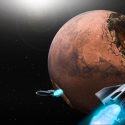Today on What If, we’re taking Jupiter’s deadly gases and unleashing them on Earth. Where could you be safe from these toxic winds? How would you breathe? And how would the Great Red Spot wreak havoc on Earth?
The gas clouds churning around Jupiter contain some of the most toxic elements ever known. So what’s in this gaseous cocktail? Well, try helium and hydrogen with a pinch of ammonia, sulfur and methane. For this experiment, we’ll scale the size of Jupiter’s atmosphere to fit Earth. But how could we transport it into our air?
Well, we’d have to go directly to the source and siphon all those gases from Jupiter. We could send a spaceship equipped to vacuum them up and bring them back to Earth. Now, that roundtrip to the gas giant and back would take about 12 years. Hopefully, that would be enough time to prepare our planet for this complete atmospheric makeover. But could it end all life on Earth?
Adding Jupiter’s atmosphere to Earth’s would put a lot more hydrogen in our air, creating a dangerous mixture. High above, explosions would rock the skyline with force so powerful it would shake the ground. Oh, and did I mention we’re increasing Earth’s gravity a bit too? Yeah, otherwise, all those gases would escape into space through the farthest layer, the exosphere.
This boundary between space and the atmosphere is razor-thin. Enjoy this view of our mini-Jupiter because from here, it only gets worse. Go one layer down, and you’d be in the thermosphere. Here, particles heated by the magnetosphere create the glowing aura that surrounds Jupiter. So Earth would have that now.
Hopefully, the thermosphere would be hot enough to destroy meteors and other debris. We’d have enough problems without falling rocks beating us. If you kept going down, you’d be floating in the stratosphere. This layer’s winds would tear up the North and South Poles. Yeah, they’d clock in as fast as 400 m/s (1,300 ft/s). That’s three times the speed of Earth’s strongest tornadoes.
But these winds would feel like a soft breeze compared to the next danger inside our new atmosphere. Now you’d be in the troposphere, right above the Earth’s surface. This layer extended to around 50 km (31 m) on Jupiter. But now on Earth, these corrosive clouds of ammonia, ammonium hydrosulfide and water vapor could reach heights of up to 20 km (12 mi).
And on Jupiter, the surface reaches below-freezing conditions. If these dense clouds blocked out most of Earth’s sunlight, temperatures would drop dramatically. To survive, we’d have to build shelters to protect us from the colder climate and poisonous gases. Maybe we’d live underground near geothermal vents, where heat escapes from the Earth’s core.
Above the surface, the air would be so deadly that a gas mask wouldn’t even save you. You’d need a space suit to withstand the gases on the ground. Without proper protection, this vortex of toxic fumes would eat away at your eyes, lungs and skin. And without enough oxygen in our atmosphere, all the plants, animals and humans would die. But our devastation would be a sight to behold.
These ammonia clouds would create spectacular red and white bands as they swirled around our planet. The dark red bands are called belts, and their gases would sink to the ground. But the cold air in the white bands, called zones, would rise. And here’s the pinnacle of those powerful gases, the storm called the Great Red Spot.
We discovered this violent hurricane on Jupiter over 400 years ago. And now we’ve brought it to Earth. And although evidence shows that the storm is shrinking, it’s still large enough to swallow Earth twice. Yeah. It wouldn’t leave us anytime soon. If this neverending storm existed on Earth, it would funnel these gases as fast as a Category 5 hurricane.
It would stretch over 640 km (398 mi), covering an area 1.5 times the size of the Grand Canyon. Its massive clouds would stretch beyond the other layers of the atmosphere and into space.
This tempest would destroy cities around the equator. Anyone not living underground would live in constant danger. From Ecuador to Congo and all the way to Indonesia, over 700 million people could be displaced or wiped out.
Earth’s imported atmosphere would look great from above, but life on Earth might be all but extinct if we brought the Great Red Spot here. OK, so what if, instead of the atmosphere, we took Jupiter’s magnetic field?
Sources
- “Jupiter’s Atmosphere & The Great Red Spot”. Nola Taylor Tillman. 2018. space.com.
- “Atmosphere”. 2022. education.nationalgeographic.org.
- “Great Red Spot | Facts, Size, & Definition”. 2022. britannica.com.
- “Hurricane Facts”. 2022. weather.gov.
- “The Sun”. 2022. mccc.edu.



























